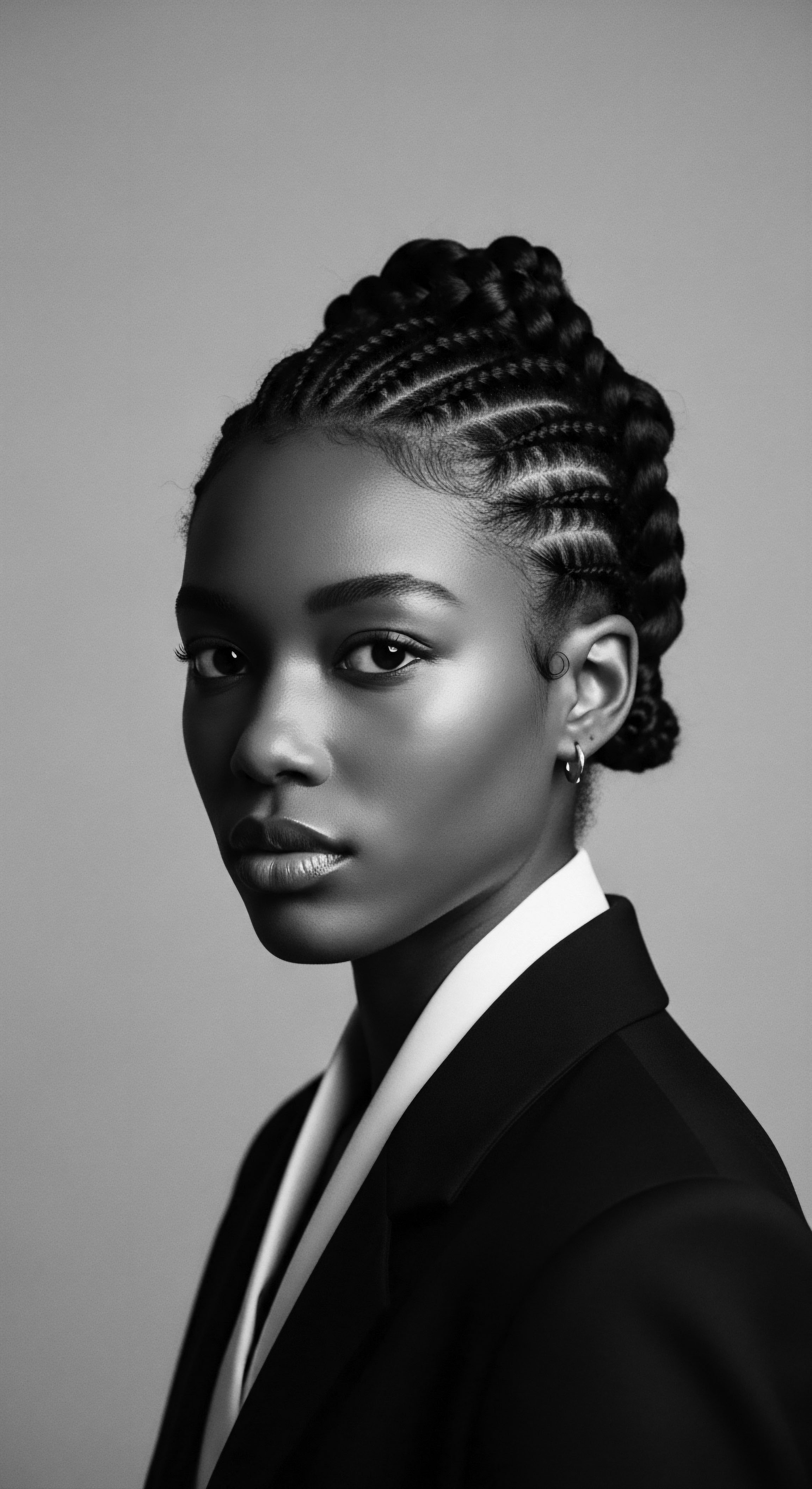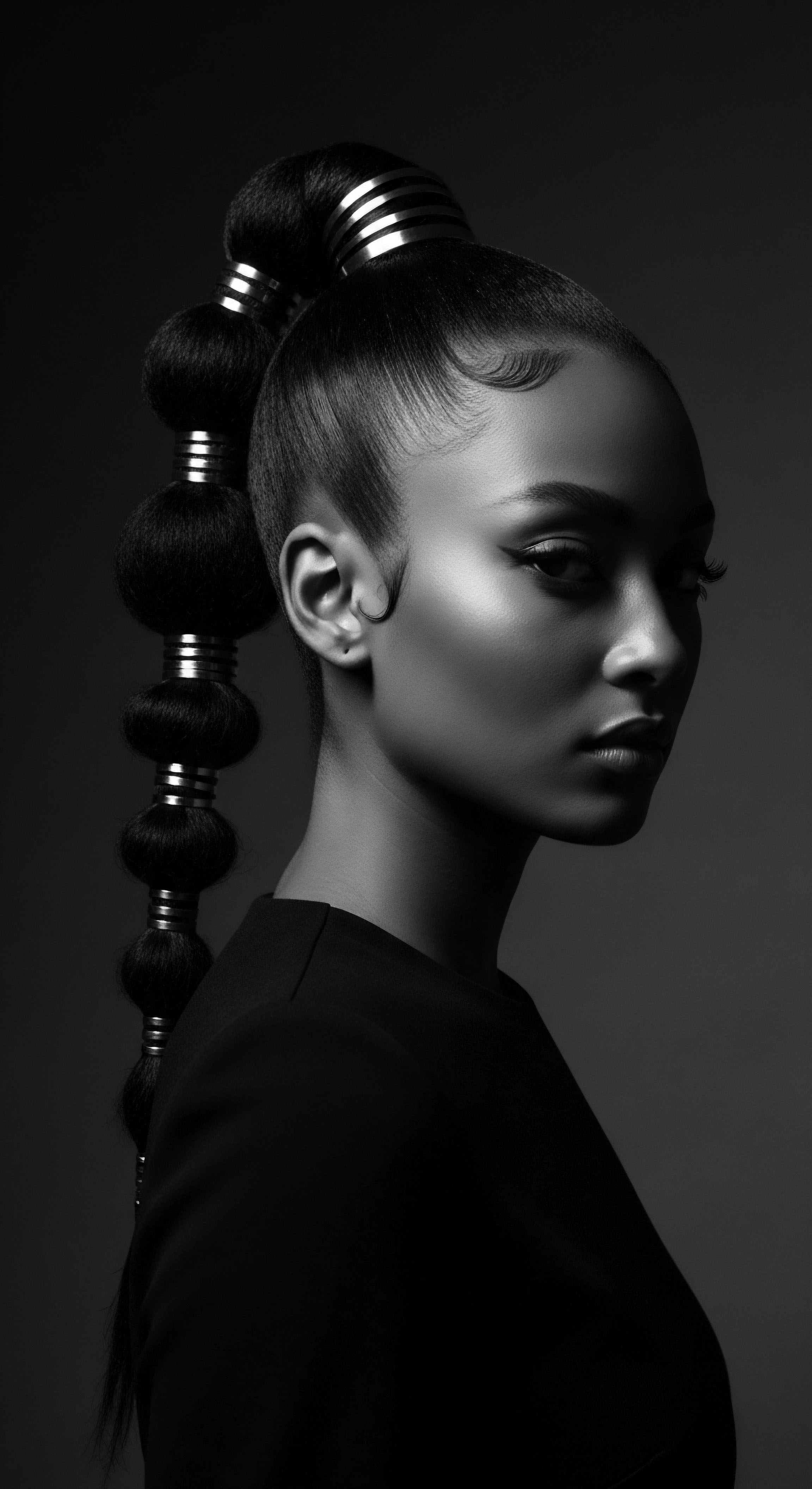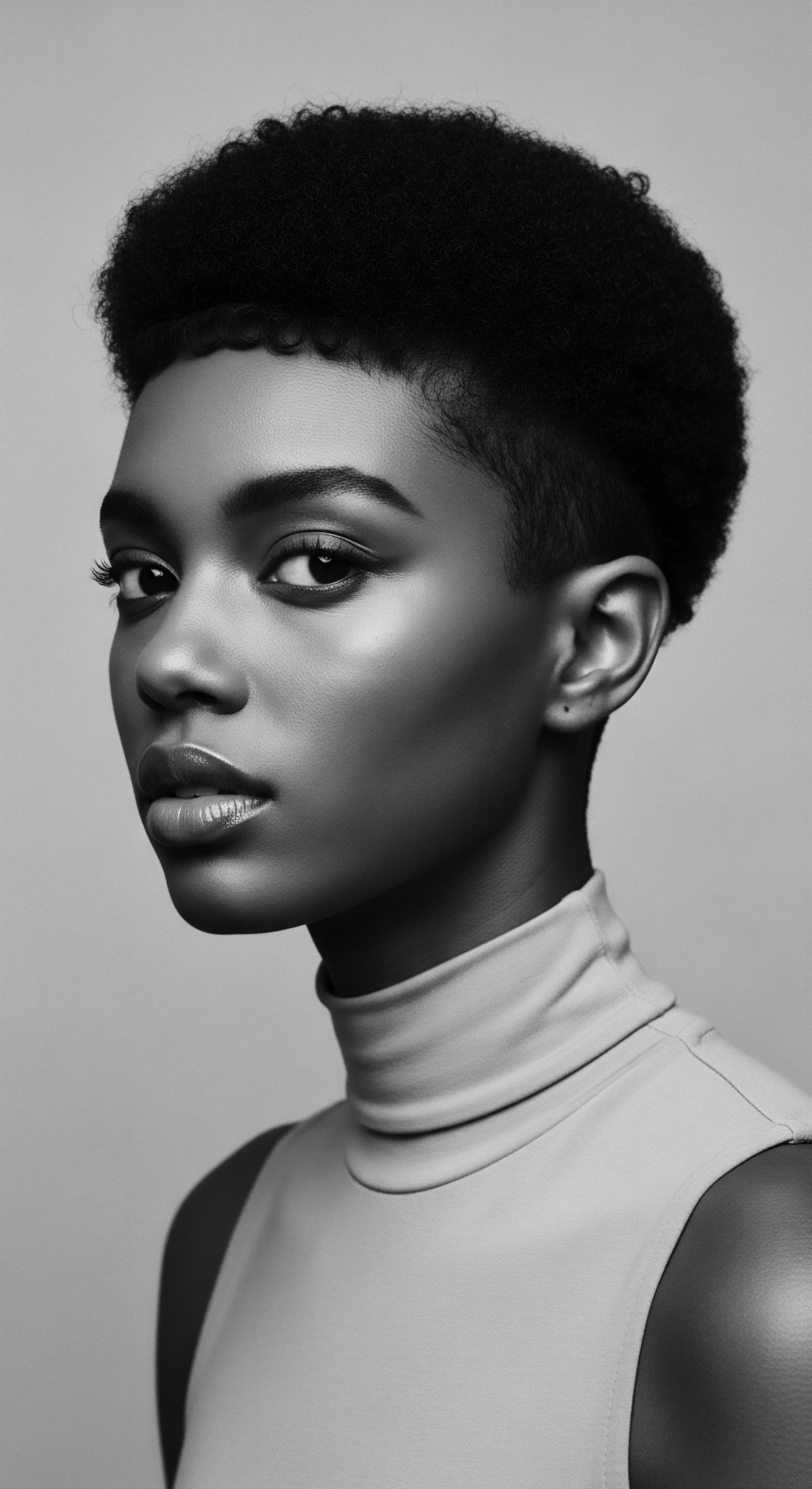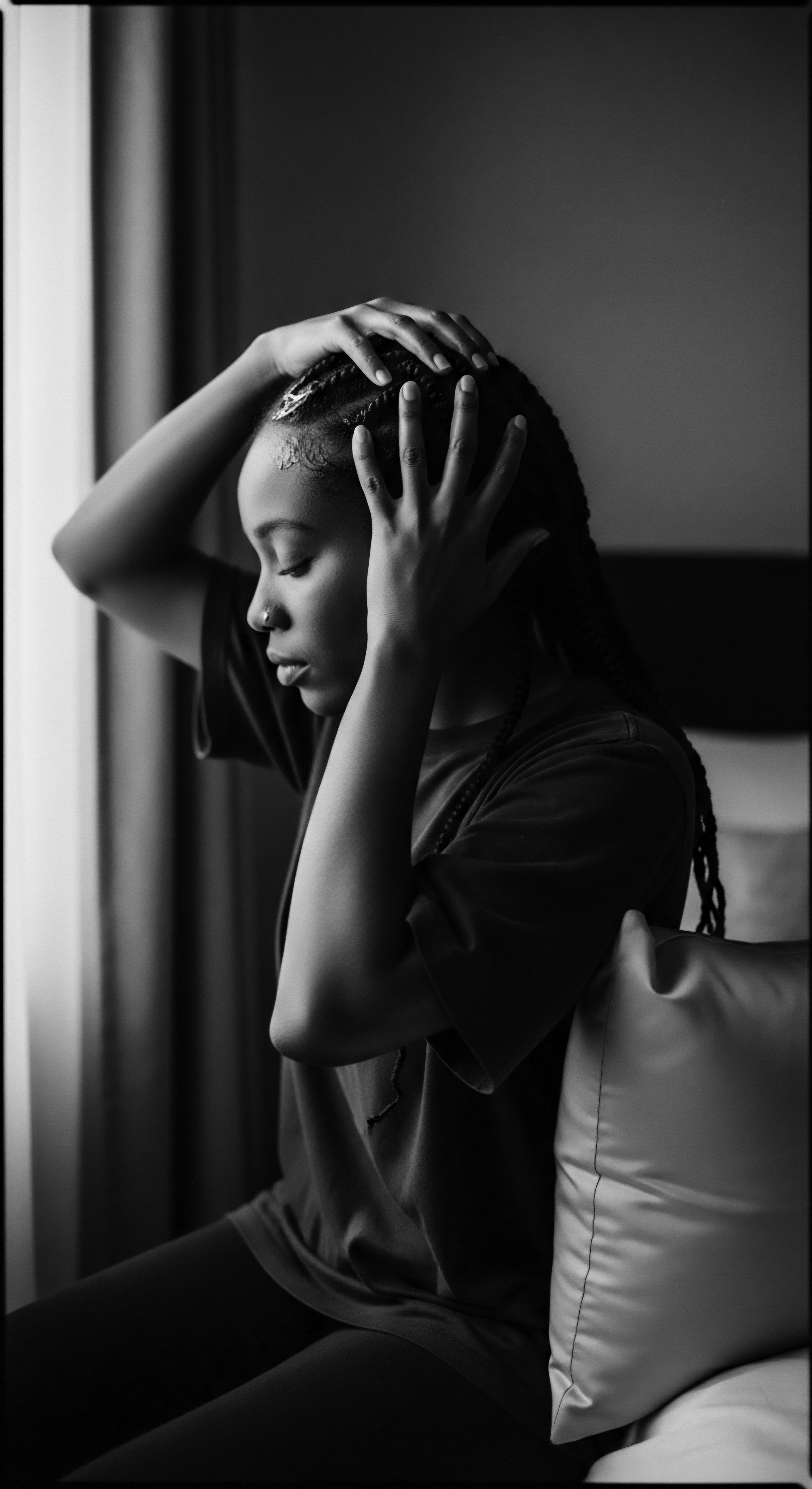
Fundamentals
The conversation surrounding Maturing Hair extends beyond a simple biological shift; it represents a profound contemplation of life’s passage, interwoven with ancestral wisdom and cultural resonance, especially within the tapestry of textured hair lineages. From the vantage point of Roothea, we perceive Maturing Hair not merely as a transformation in follicular structure, but as a living testament to time, experience, and an ongoing connection to the very origins of our being. A basic understanding acknowledges that as one journeys through life, hair undergoes a series of natural, age-related modifications, a universal phenomenon yet distinctly colored by the unique characteristics of coily, kinky, and wavy strands.
At its simplest, Maturing Hair refers to the hair that begins to exhibit alterations in its fundamental composition and appearance due to the passage of years. These initial indications typically manifest as changes in pigmentation, commonly recognized as the emergence of lighter, often white or silver, strands. This visible shift stems from a decrease in melanin production within the hair follicles. Melanin, the natural pigment that grants hair its hue, diminishes in quantity over time, leading to a gradual lightening process.
The hair’s structural characteristics also begin to modify; strands might exhibit changes in density, often feeling somewhat thinner than in earlier decades. There might also be a subtle adjustment in the intrinsic texture, presenting a different responsiveness to moisture and styling efforts.
Maturing Hair, in its fundamental sense, marks a natural progression in a strand’s existence, a visual record of life’s unfolding and the inherent shifts within each follicle.
Long before modern science elucidated the cellular mechanisms behind these transformations, ancestral communities observed these visible shifts in hair. They possessed an intuitive knowledge of hair as a living entity, responsive to the rhythms of life and the environment. These communities recognized the lightening of hair as a natural indicator of seniority and the accumulation of lived wisdom.
Rather than viewing it as a deficiency, many cultures regarded such changes with respect, often celebrating them as visible markers of a person’s passage into revered elder status. This acknowledgment shaped early practices of hair care.
Traditional methods for supporting hair through its natural life cycle often focused on nourishment and protection, drawing upon the bounty of the earth. These were not merely cosmetic rituals; they were acts of reverence. Simple formulations derived from local botanicals, natural oils, and butters were applied to keep hair supple and resilient. Such applications helped to mitigate the increasing dryness that can accompany maturing hair, providing a protective sheath against environmental exposures.
Our ancestors understood, through generations of observation, that the hair, like the individual, required gentle, consistent attention to maintain its vitality. These practices established a foundational legacy of care, echoing into contemporary approaches to hair wellness.

The Early Signs and Their Ancient Interpretations
The very first indications of Maturing Hair often appear as a scattering of lighter threads among the darker ones, particularly around the temples or hairline. This biological reality, termed ‘canities’ in scientific discourse, signals a gradual reduction in the melanocytes, the specialized cells residing within hair follicles responsible for producing melanin. As these cells become less active or cease to function, the keratinized protein that forms the hair shaft incorporates less pigment, leading to white or gray strands. Yet, for countless generations, this sight was rarely met with alarm.
In numerous African traditions, the appearance of gray or white hair marked a significant transition, signaling a new phase of social standing. It denoted a visible increase in wisdom, experience, and proximity to the ancestors. An individual whose hair began to lighten might find themselves accorded greater deference within their community, their voice carrying increased weight in communal discussions.
This reverence stands in stark contrast to contemporary Western beauty standards that frequently associate gray hair with a decline in youth or vitality, often prompting efforts to conceal it. Our ancestors understood that graying was a natural unfolding, a visual signifier of earned respect.
- Melanin Reduction ❉ The most prominent biological change in Maturing Hair involves the diminishing activity of melanocytes, leading to a decrease in hair pigmentation.
- Texture Shift ❉ As hair ages, changes in the follicle can affect the hair’s diameter and porosity, sometimes resulting in a finer or coarser feel.
- Moisture Needs ❉ Maturing hair often experiences a reduction in natural sebum production, necessitating increased external moisture and conditioning.

Intermediate
Transitioning to a more nuanced understanding of Maturing Hair requires a deeper look into the intricate biological processes at play, coupled with an exploration of how these changes specifically affect textured hair. It also allows us to appreciate the profound continuity between ancient care rituals and modern scientific insights. Maturing Hair, viewed through this lens, becomes a testament to the enduring adaptability of textured strands and the ingenuity of those who have tended them across generations.
At an intermediate level, the physiological shifts involved in Maturing Hair extend beyond mere pigment loss. The hair follicle itself undergoes a series of subtle yet impactful alterations. We see a decrease in the number of active follicles, leading to a reduction in overall hair density. Each individual strand can also experience a reduction in its diameter, meaning the hair often becomes finer.
Furthermore, the integrity of the cuticle, the outermost protective layer of the hair shaft, can become compromised over time. This makes the hair more susceptible to damage from external factors, and it can also affect how light reflects off the hair, sometimes contributing to a duller appearance. The production of sebum, the natural oil that lubricates the scalp and hair, tends to diminish with age. This reduction can cause the hair to become increasingly dry and brittle, making it more prone to breakage.
Maturing Hair represents not a decline, but a recalibration of follicular activity, inviting a refined approach to care that honors its new needs and enduring spirit.
These changes present unique considerations for textured hair, which by its very nature, possesses a distinct structure. Coily, kinky, and wavy hair strands have an elliptical or flat shape, with a more open cuticle structure compared to straighter hair types. This inherent characteristic makes textured hair naturally more prone to dryness. When the effects of maturation—reduced sebum and a compromised cuticle—are superimposed upon this natural predisposition, the potential for dryness and fragility increases.
Curl patterns might also relax or become less defined, and the hair can develop a coarser feel or exhibit greater frizz. The delicate balance of moisture and elasticity, so crucial for maintaining the integrity and definition of textured strands, becomes even more significant as hair matures.

Echoes from the Source ❉ Traditional Practices and Their Enduring Wisdom
Throughout the ages, particularly within Black and mixed-race communities, a deep wellspring of traditional knowledge existed for nourishing and protecting hair through every stage of life. These practices, often passed down through oral tradition and lived experience, intuitively addressed the very challenges now elucidated by modern science. Our ancestors cultivated a symbiotic relationship with the land, drawing on botanical resources to formulate potent elixirs.
Consider the reverence for various oils and butters in West African traditions. Shea Butter, for instance, a staple in many communities, was not simply a moisturizer; it was a revered substance used to condition hair, protect it from the harsh sun, and seal moisture into the strands. This traditional use directly speaks to the increased dryness associated with Maturing Hair.
Similarly, the meticulous practice of Hair Oiling, using blends of locally sourced plant oils, provided essential lipids to the scalp and hair, compensating for diminished natural sebum. These were not random applications; they were deliberate acts rooted in generations of observation and understanding of hair’s evolving needs.
The strategic use of Protective Styles also stands as a testament to ancestral ingenuity. Braids, twists, and various forms of intricate coiling served multiple purposes ❉ they communicated social status, marked rites of passage, and shielded delicate hair strands from environmental wear and tear. For maturing hair, these styles minimized manipulation, reduced breakage, and conserved precious moisture, allowing the hair to rest and retain its strength. The longevity of these practices, enduring through centuries and across continents, underscores their efficacy and their profound connection to the unique requirements of textured hair as it matures.

The Living Archive ❉ Hair as a Repository of Heritage
The concept of hair as a living archive holds particular weight when contemplating Maturing Hair within textured hair heritage. Each strand, in its shift of color and texture, carries the echoes of time. It tells a story of survival, adaptation, and resilience. For Black and mixed-race individuals, hair has always been far more than a biological appendage; it has served as a profound repository of identity, a visual language of belonging, and a powerful symbol of resistance against systems that sought to dehumanize.
The graying of hair, in particular, speaks volumes. It connects the individual directly to a lineage of elders, to those who have walked before, weathered storms, and accrued invaluable wisdom. This perspective stands in direct opposition to narrow, Eurocentric beauty ideals that often pressure individuals to conceal signs of aging.
Instead, within traditions that honor ancestral pathways, Maturing Hair can become a source of strength, a visible thread linking the present self to a deep and continuous stream of heritage. It compels us to listen to the whispers of the past, acknowledging the wisdom that emerges with each silver strand.
- Follicular Density Reduction ❉ As one ages, fewer active hair follicles remain, leading to an overall reduction in the thickness of the hair.
- Cuticle Integrity Decrease ❉ The protective outer layer of the hair can weaken, making strands more vulnerable to damage and moisture loss.
- Sebum Production Decline ❉ The scalp produces less natural oil, contributing to increased dryness and a greater need for external conditioning.

Academic
The academic elucidation of Maturing Hair transcends a mere biological description, offering a multifaceted understanding that integrates trichological science with profound socio-cultural and historical contexts, particularly as they pertain to textured hair. This scholarly perspective positions Maturing Hair as a dynamic interplay of intrinsic biological processes, environmental influences, and deeply embedded cultural interpretations. It signifies a complex phenomenon that informs identity, social hierarchy, and the continuity of ancestral practices across generations.

A Comprehensive Explanation of Maturing Hair
From an academic viewpoint, Maturing Hair delineates the sequential, genetically influenced physiological alterations occurring within the pilosebaceous unit over an individual’s lifespan. The primary biological markers involve changes in hair pigmentation, density, and structural integrity.
The most discernible alteration is the onset of canities, the graying or whitening of hair. This phenomenon arises from the gradual decline in melanogenesis, the biochemical process of melanin production, within the hair follicle’s melanocytes. These specialized pigment-producing cells, located at the base of the hair follicle, experience a reduction in their number and activity over time. The subsequent decrease in eumelanin (responsible for black and brown pigments) and pheomelanin (responsible for red and yellow pigments) leads to hair strands forming without pigment, resulting in white hair.
Gray hair presents as an optical illusion, a blend of pigmented and unpigmented strands on the scalp. Research suggests that while the exact mechanism remains under investigation, increased oxidative stress within the follicular environment contributes to melanocyte senescence and apoptosis (Maymone et al. 2021).
Beyond pigmentation, Maturing Hair exhibits alterations in the hair cycle itself. The anagen (growth) phase shortens, while the telogen (resting) phase lengthens, leading to a higher proportion of hair in the resting phase at any given time. This shift contributes to a reduction in overall hair density and an increased perception of thinning. Individual hair strands may also experience a decrease in diameter, resulting in finer hair texture.
The hair shaft’s structural components, specifically the keratin proteins and lipid layers, can become compromised, leading to increased porosity, reduced elasticity, and a more fragile cuticle layer (Maymone et al. 2021). This reduced cuticle integrity makes the hair more vulnerable to environmental aggressors and mechanical stress, impacting its overall strength and resilience. Furthermore, the sebaceous glands, responsible for producing sebum, tend to become less active with age, diminishing the hair’s natural lubrication and predisposing it to dryness and brittleness.
In the context of textured hair, these physiological changes carry distinct implications. The inherent helical structure of coily, kinky, and curly hair types renders them naturally more susceptible to dryness and breakage due to the open cuticle structure and the natural twists and turns along the hair shaft. As hair matures, the compounded effects of reduced sebum production, increased porosity, and diminished cuticle integrity can exacerbate these predispositions.
Curl patterns may loosen or become inconsistent, and the hair can exhibit greater susceptibility to tangling and frizz. The management of Maturing Hair within textured communities therefore demands specialized attention, balancing biological realities with time-honored practices for moisture retention and protective styling.
Maturing Hair, from an academic lens, encapsulates the biological shifts of pigmentation and density, critically intersecting with cultural understandings of age, identity, and the inherited resilience of textured strands.

Interconnected Incidences ❉ Maturing Hair, Identity, and Societal Narratives
The study of Maturing Hair extends into the realms of anthropology and sociology, revealing its intricate connections to individual and collective identity, social perception, and public health. For individuals of African descent, hair has historically served as a potent symbol of identity, cultural heritage, and resistance against systems of oppression (Tarlo, 2016; Byrd & Tharps, 2014). The progression of hair aging, particularly the appearance of gray or white strands, activates a unique set of cultural narratives that diverge significantly from Eurocentric beauty ideals.
In many Western societies, gray hair has frequently been associated with a decline in youth and beauty, often leading to societal pressure to conceal it. This perspective can contribute to feelings of anxiety or self-consciousness, particularly for women (Maymone et al. 2021). However, a profoundly different narrative exists within numerous African and diasporic cultures, where Maturing Hair is venerated.
The appearance of gray strands is frequently celebrated as a visible manifestation of wisdom, experience, and an elevated social status. It is a signifier of a life lived, lessons learned, and knowledge accumulated over decades.

The Crown of the Aged ❉ A Yoruba Illustration
A powerful illustration of this cultural valuation comes from the Yoruba People of Southwestern Nigeria. In Yoruba cosmology, the head, or Ori, is considered the most sacred part of the body, the seat of an individual’s destiny, character, and inner essence (Alabi, 2024). As such, the hair, being an extension of the Ori, carries immense spiritual and social significance. It is not merely an aesthetic feature; it is a profound marker of one’s spiritual alignment and social standing.
Within Yoruba society, the visible signs of aging, particularly graying hair, are not only accepted but are explicitly revered. The Yoruba proverb “Ori ni ile, irun ni ade,” meaning “The head is a home, hair is a crown,” speaks to this deep reverence. Indeed, gray hair is often referred to as “the crown of the aged” (Agwuele, 2024). This designation is not simply poetic; it reflects a deeply ingrained cultural system where seniority is a paramount principle of social organization (Agwuele, 2024).
Elders, visibly marked by their graying hair, are accorded profound respect, their opinions carrying significant weight in communal decisions and conflict resolution. They are regarded as living repositories of ancestral knowledge and wisdom, their physical appearance mirroring their spiritual and intellectual authority.
This cultural framework mitigates some of the negative psychological impacts associated with graying hair in Western contexts. For a Yoruba elder, the emergence of white strands signals a deepening connection to their lineage and ancestors, reinforcing their position as a respected pillar of the community. A study by Agwuele (2024) highlights that Yoruba people primarily judge seniority based on physical features, with gray hair being a chief indicator, thereby reinforcing its perception as a highly valued trait. This demonstrates a distinct cultural counter-narrative, where Maturing Hair is not something to be concealed, but rather a badge of honor, openly displayed and celebrated.
This cultural perspective profoundly shapes the self-perception and subjective well-being of older Black individuals within such traditions, fostering a sense of pride and continuity with their heritage (Daniels et al. 2023).

Contemporary Realities and Research Insights
Modern research confirms distinct patterns in hair aging across different ethnic groups. The average age of onset for gray hair in individuals of African descent is typically in their mid-forties, a later average compared to Caucasians (mid-thirties) or Asians (late thirties) (Maymone et al. 2021). This observation correlates with studies indicating that African hair samples possess larger melanosome sizes and higher melanosome density (Maymone et al.
2021). This biological resilience in maintaining pigment for longer speaks to the strength and unique characteristics of textured hair at a cellular level.
However, the societal pressure to conform to Eurocentric beauty standards has historically influenced hair practices even as hair matures. Despite the biological and cultural specificities, a study examining older Black women in the UK found a statistically significant shift towards less frequent use of complex hair styles and visits to hairdressers over a 30-year period (Daniels et al. 2023). Interestingly, the frequency of hair coloring was not impacted, suggesting a complex negotiation between managing graying hair for personal and social identity, alongside the desire to maintain cultural continuity (Daniels et al.
2023). This underscores the ongoing tension between inherited cultural valuation and contemporary beauty norms, even as individuals mature.
| Traditional Practice Shea Butter Application |
| Underlying Principle (Ancestral Wisdom) Deep conditioning, sun protection, moisture sealing for strand health. |
| Modern Scientific Correlation Rich in fatty acids and vitamins, providing occlusive benefits and reducing trans-epidermal water loss. |
| Traditional Practice Hair Oiling Rituals |
| Underlying Principle (Ancestral Wisdom) Nourishing scalp and hair, compensating for natural dryness, promoting suppleness. |
| Modern Scientific Correlation Delivers essential lipids, enhances cuticle integrity, and provides antioxidants, supporting scalp microcirculation. |
| Traditional Practice Protective Hairstyling (Braids, Twists) |
| Underlying Principle (Ancestral Wisdom) Minimizing manipulation, reducing breakage, safeguarding delicate ends, maintaining length. |
| Modern Scientific Correlation Reduces mechanical stress, minimizes environmental exposure, and allows for extended periods of moisture retention. |
| Traditional Practice Herbal Rinses and Infusions |
| Underlying Principle (Ancestral Wisdom) Cleansing, strengthening, and conditioning with natural botanicals, addressing scalp conditions. |
| Modern Scientific Correlation Plant compounds offer anti-inflammatory, antimicrobial, and antioxidant properties, supporting follicle health and hair strength. |
| Traditional Practice These ancestral practices reveal a profound intuitive understanding of hair's needs, often validated by contemporary scientific inquiry. |

Long-Term Consequences and Societal Impact
The societal implications of how Maturing Hair is perceived and managed within Black and mixed-race communities extend to long-term psychological well-being and cultural continuity. When a society actively devalues visible signs of aging, it can contribute to internalized ageism and a diminished sense of self-worth among its older members. However, in contexts where gray hair is honored, individuals may experience greater self-acceptance and pride in their life journey. This cultural framing directly impacts mental health, fostering a more positive self-image and reinforcing intergenerational respect.
The choice to openly display Maturing Hair, particularly in professional or public spheres, can become an act of self-assertion, challenging prevailing beauty norms and reaffirming cultural heritage. This contributes to a broader cultural shift, encouraging greater diversity in representation and beauty standards. Moreover, the continuity of ancestral hair care practices for Maturing Hair ensures the transmission of knowledge across generations, preserving unique forms of cultural expression and communal bonding.
Hair care rituals, particularly for older individuals, often serve as vital moments of intergenerational exchange, where wisdom and stories are shared alongside techniques for hair preservation. This sustained practice plays a crucial role in maintaining cultural memory and identity, allowing the “Soul of a Strand” to continue its narrative through time.

Reflection on the Heritage of Maturing Hair
As our contemplation of Maturing Hair draws to a close, a singular truth emerges ❉ this journey of transformation, marked by silver threads and subtle shifts, is not an ending but a continuation. It stands as a powerful testament to the enduring heritage of textured hair, a narrative of resilience woven through centuries of ancestral wisdom and lived experience. The changes witnessed in Maturing Hair are deeply linked to the passage of time. They are also inseparable from the stories of communities where hair has always been a profound expression of identity, spirituality, and social standing.
The journey from elemental biology, through the tender threads of care, to the unbound helix of identity, reveals Maturing Hair as a symbol of profound continuity. It reminds us that our hair holds memory, echoing the strength and ingenuity of those who came before us. We recognize the invaluable legacy of ancestral practices, from the diligent application of plant-based emollients to the creation of protective styles that safeguarded strands and souls alike. These traditions, born of necessity and deep observation, offer timeless lessons for nurturing our hair as it moves through its life stages.
Maturing Hair is a profound expression of our journey, a visible testament to the heritage, wisdom, and enduring beauty within each textured strand.
To truly appreciate Maturing Hair means to look beyond superficial beauty standards and to find the profound beauty in a life lived, in wisdom accumulated, and in the tangible connection to our roots. It is an invitation to honor the inherent dignity of the aging process, celebrating each silver strand as a precious mark of experience. For Roothea, the Maturing Hair is a living archive, a narrative that continues to unfold, speaking volumes of ancestral resilience and the timeless beauty that resides within every unique helix.
It calls upon us to listen to its whispers, to learn from its journey, and to carry forward a legacy of care and reverence for the generations yet to come. The soul of a strand, indeed, continues its vibrant song through every stage of its glorious existence.

References
- Agwuele, A. (2024). Greyness Is Aged, Bearded Is Adult ❉ Yoruba Age and Seniority. Nordic Journal of African Studies, 33(4).
- Alabi, T. O. (2024). Mouth matters ❉ Exploring the intersection of Yoruba cultural beliefs, metaphysical significance, and oral health practices. African Anthropologist, 22(2).
- Byrd, A. D. & Tharps, L. D. (2014). Hair Story ❉ Untangling the Roots of Black Hair in America. St. Martin’s Press.
- Daniels, J. Gendelman, E. Hajat, S. Lumsden, K. Murray, A. & Williams, S. (2023). “I am now being who I am and I’m proud of it” ❉ Hair related personal and social identity and subjective wellbeing of older Black women in the UK. Quality in Ageing and Older Adults.
- Maymone, M. B. C. Laughter, M. Pollock, S. Khan, I. Marques, T. Abdat, R. Goldberg, L. J. & Vashi, N. A. (2021). Hair Aging in Different Races and Ethnicities. The Journal of Clinical and Aesthetic Dermatology, 14(1).
- Tarlo, E. (2016). Hair ❉ A Cultural History. University of California Press.
